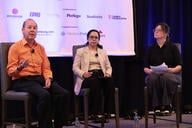You have /5 articles left.
Sign up for a free account or log in.
I read the piece in The Wall Street Journal earlier this week about the declining share of college students who are men. I followed it with reading various critiques of the piece, some of which were quite good.
My quick take is that it’s frustrating to see a serious issue reduced to a prop in a culture war to which it’s mostly unrelated.
Any serious analysis of the growing gender gap in college enrollment (bad enough) and graduation (even worse) needs to start by disaggregating the data. It’s worse for Black and Latino men, and it’s most pronounced at community colleges. Start there.
Community colleges have lower tuition than most other places, but much of the time, the issue isn’t tuition as much as it is opportunity cost. In a heterosexual couple, if his job pays better than hers, then it’s easier to send her to college than to send him. The opportunity cost is lower. The perverse side effect of higher wages for men without degrees is that it’s harder -- the opportunity cost is higher -- for men to get degrees. That’s most salient for men who have the least economic cushion; they’re the ones who can least afford not to work for pay.
The greater the economic polarization in the larger society, the riskier it is to give up a decent-paying job to get a degree. Fear of falling is real. COVID accelerated a trend that had been going on for years, probably because the pandemic-driven recession threw so many people -- especially women -- out of work.
Community colleges need to take on the challenge of improving outcomes among those who need it the most, and many, including my own, are stepping up. But there’s a much larger economic issue against which we’re struggling, even though most people don’t connect the dots: improving economic opportunities for women will improve college opportunities for men.
At its base, this isn’t about setting one sex against another. It’s about making it possible for people to make choices without economic coercion effectively dictating them. If it’s possible to study and not starve, more will study; we see that in the college-going rates of the upper middle class. My son can attend college full-time because we’re supporting him; he may have to live modestly, but he’s not couch-surfing. He has enough to eat, reliably. That frees up bandwidth for classes. Given similar security, I suspect many other men would do the same.
The Wall Street Journal story focused on admit rates at Kenyon. No disrespect, but our admit rate is 100 percent, and our gaps are larger than theirs. If you get the basics wrong, the rest will follow.
--
At The Girl’s recommendation, we spent a few weeks watching the first two seasons of Never Have I Ever on Netflix. It won me over quickly; it’s a comedy about a deeply flawed character who is trying, fitfully, to be better. That storyline is one of my favorites, especially when it’s done comedically. It can be Laura Dern in Enlightened, Bojack in Bojack Horseman or Devi in Never Have I Ever; it works every time.
The show is set in high school, and it follows Devi’s struggle to recover from her father’s abrupt death while navigating relationships at an affluent high school. John McEnroe, the tennis player, provides stilted yet oddly appropriate narration.
Season one ends in a love triangle, with Devi torn between brooding heartthrob Paxton (played by a 30-year-old actor) and callow-but-well-meaning Ben. TG asked if I was on Team Paxton or Team Ben. I told her I’m on Team Eleanor. Eleanor, played by Ramona Young, is the obvious breakout star of the show. She’s laugh-out-loud funny.
My plea to casting directors everywhere: hire her! I haven’t seen comic delivery that precise in a long, long time. I’m not a fan of spinoffs generally, but she’s a star. Hire Ramona Young!
--
The Girl had her first day of senior year Thursday, which was also her first day of in-person classes since March of 2020.
She gave us a full recap. My favorite part was her description of lunch:
“The chicken, bun and fries were all one color.”
The writer in me had to tip my cap.



